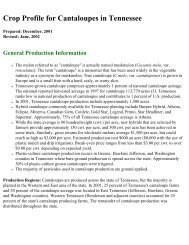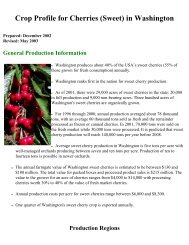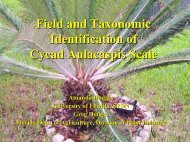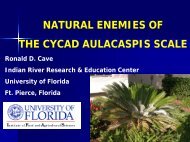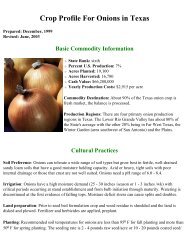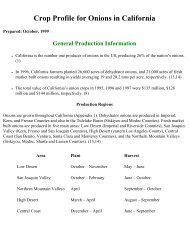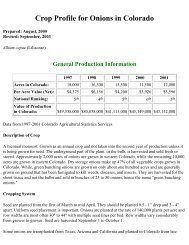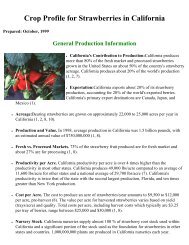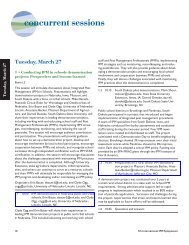Crop Profile for Onions in New York - Regional IPM Centers
Crop Profile for Onions in New York - Regional IPM Centers
Crop Profile for Onions in New York - Regional IPM Centers
Create successful ePaper yourself
Turn your PDF publications into a flip-book with our unique Google optimized e-Paper software.
Prepared: May, 1999<br />
<strong>Crop</strong> <strong>Profile</strong> <strong>for</strong> <strong>Onions</strong> <strong>in</strong> <strong>New</strong> <strong>York</strong><br />
General Production In<strong>for</strong>mation<br />
<strong>Onions</strong> are one of the most important vegetable crops <strong>in</strong> <strong>New</strong> <strong>York</strong> <strong>in</strong> terms of crop value.<br />
The pr<strong>in</strong>ciple type of onion grown is the pungent yellow globe, and most are produced on<br />
muck (high organic matter) soils. Costs of production are higher <strong>for</strong> onions than any<br />
other vegetable crop <strong>in</strong> <strong>New</strong> <strong>York</strong>. Several <strong>in</strong>sects and numerous diseases attack onions,<br />
and control of these currently relies on the frequent use of pesticides. Because onions<br />
compete poorly with weeds, weed control is an important and costly management issue.<br />
Without the registration of new effective materials to replace them, the loss of chlorpyrifos<br />
(<strong>for</strong> onion maggot control); the fungicides chlorothalonil, maneb, mancozeb, or iprodione; and<br />
the herbicides pendimethal<strong>in</strong>, metolachlor, oxyfluorfen, bromoxynil, clethodim, or fluazifop<br />
p-butyl, would have significant impacts on production and profitability. In addition, the<br />
<strong>in</strong>dustry has critical needs <strong>for</strong> the follow<strong>in</strong>g (not <strong>in</strong> prioritized order): 1) federal and<br />
state registration of cyromaz<strong>in</strong>e <strong>for</strong> onion maggot control; 2) availability of effective,<br />
non-pyrethroid <strong>in</strong>secticides <strong>for</strong> resistance management <strong>in</strong> onion thrips; 3) federal and<br />
state registration of dimethenamid <strong>for</strong> control of yellow nutsedge; 4) federal and state<br />
registration of oxamyl or another effective nematode control; 5) effective controls <strong>for</strong> bulb mites and bacterial diseases; and<br />
6) more effective controls <strong>for</strong> smut.<br />
Registration of new materials by the EPA, even those designated as "low risk", does not guarantee that NY growers will<br />
have immediate access to them. The <strong>New</strong> <strong>York</strong> State Department of Environmental Conservation conducts its own <strong>in</strong>depth<br />
reviews be<strong>for</strong>e register<strong>in</strong>g new pesticides <strong>for</strong> use <strong>in</strong> NY, and may or may not register new materials <strong>for</strong> portions of or<br />
<strong>for</strong> the entire state.<br />
Basic Commodity In<strong>for</strong>mation<br />
State Rank: 6<br />
% U.S. Production: 5.7%<br />
Acres Planted: 12,500<br />
Acres Harvested: 12,200<br />
Cash Value: $39,276,000<br />
Yearly Production Costs: $2654 (estimated, 1993)<br />
Commodity Dest<strong>in</strong>ation(s):<br />
❍ Fresh Market: 98%<br />
❍ Process<strong>in</strong>g: 2%<br />
Production Regions: <strong>Onions</strong> are primarily grown on muck (organic) soils found <strong>in</strong> Orange, Oswego, Orleans,<br />
Genesee, Madison, Wayne, Yates, and Steuben counties.<br />
Cultural Practices
<strong>Onions</strong> are mostly direct seeded <strong>in</strong> the field although some are transplanted as seedl<strong>in</strong>gs or sets. Transplants are<br />
sometimes used to improve bulb size, to hasten maturity, or to avoid <strong>in</strong>fection by some plant diseases, but this method of<br />
crop establishment is more expensive. Plant<strong>in</strong>g occurs from late March through early May. Most onions are grown on<br />
muck soils, however some onions are be<strong>in</strong>g successfully grown on well-dra<strong>in</strong>ed m<strong>in</strong>eral soils with supplemental irrigation<br />
and fertilizer. Because of their very high cost of production, high value, and specialized soil type needs, onions are not<br />
always rotated with other crops.<br />
Between-row spac<strong>in</strong>g varies considerably depend<strong>in</strong>g upon weed and foliar disease management, seeder capability,<br />
and harvest<strong>in</strong>g equipment. With<strong>in</strong>-row spac<strong>in</strong>g also varies depend<strong>in</strong>g upon variety, desired bulb size, between row spac<strong>in</strong>g,<br />
soil type, and other management considerations. The use of irrigation is <strong>in</strong>creas<strong>in</strong>g <strong>in</strong> most of the onion produc<strong>in</strong>g regions<br />
of the state.<br />
Barley w<strong>in</strong>dbreaks are typically planted on muck soils at the same time as onion seed<strong>in</strong>g. Barley emerges and grows<br />
much more quickly than onions, provid<strong>in</strong>g protection aga<strong>in</strong>st w<strong>in</strong>d erosion and subsequent onion seedl<strong>in</strong>g damage. Once<br />
the onions are established, the w<strong>in</strong>dbreaks are killed with a selective herbicide. W<strong>in</strong>d damage can be significant, and total<br />
crop loss due to w<strong>in</strong>ds <strong>in</strong> May or early June is not rare.<br />
Once onion leaves have senesced and the necks have sealed, bulbs can be harvested. About 7 days prior to harvest, bulbs<br />
are undercut to hasten the process. The mature onions are then lifted and the tops are cut to leave about 2 <strong>in</strong>ches of neck.<br />
This ensures a tight seal after dry<strong>in</strong>g and cur<strong>in</strong>g to prevent the <strong>in</strong>vasion of storage pathogens. The bulbs are harvested<br />
<strong>in</strong>to trucks and may be further cured with <strong>for</strong>ced air and a dry<strong>in</strong>g temperature of 85-90 o F, be<strong>for</strong>e be<strong>in</strong>g placed <strong>in</strong> storage.<br />
A high percentage of onions grown <strong>in</strong> NY are stored <strong>for</strong> market<strong>in</strong>g throughout the fall, w<strong>in</strong>ter, and early spr<strong>in</strong>g. For longterm<br />
storage, the sprout <strong>in</strong>hibitor maleic hydrazide is used just be<strong>for</strong>e onions are undercut (approximately 60% crop treated;<br />
2 lb ai/acre).<br />
In Orange County, many growers produce some of their own onion seed <strong>for</strong> certa<strong>in</strong> varieties of early matur<strong>in</strong>g onions.<br />
After storage over w<strong>in</strong>ter, bulbs are selected <strong>for</strong> size and disease-free status, and planted <strong>in</strong> small plots located away from<br />
the ma<strong>in</strong> onion crop. Pests <strong>in</strong> seed onions are managed <strong>in</strong> a similar manner to the ma<strong>in</strong> crop, although fungicides may be<br />
used more frequently <strong>in</strong> order to m<strong>in</strong>imize seed-borne diseases.<br />
Onion Maggot (Delia antiqua)<br />
Frequency of Occurrence: Annually.<br />
Insect Pests<br />
Damage Caused: Onion maggot larvae feed on the belowground hypocotyl tissue of seedl<strong>in</strong>gs, result<strong>in</strong>g <strong>in</strong> a variety<br />
of damag<strong>in</strong>g symptoms. Larval feed<strong>in</strong>g may kill seedl<strong>in</strong>gs; there<strong>for</strong>e, poor plant stands may <strong>in</strong>dicate an onion maggot<br />
problem. In larger plants, larvae may tunnel <strong>in</strong>to the bulb caus<strong>in</strong>g plants to become flaccid and yellow. Later<br />
generations damage bulbs, often caus<strong>in</strong>g them to rot, and render<strong>in</strong>g them unfit <strong>for</strong> sale or consumption.<br />
% Acres Affected: 100%<br />
Pest Life Cycles: Onion maggots are highly host-specific to plants <strong>in</strong> the onion family. The <strong>in</strong>sect overw<strong>in</strong>ters as pupae <strong>in</strong><br />
the soil associated with onion culls <strong>in</strong> the field or <strong>in</strong> onion cull piles. Adults emerge about mid-May and mate over a threeday<br />
period after which they beg<strong>in</strong> lay<strong>in</strong>g their t<strong>in</strong>y white eggs at the base of the plant. The larvae, upon emergence,<br />
crawl beneath the leaf sheath and enter the bulb. The onion maggot pupates <strong>in</strong> the soil and the subsequent generation of<br />
adults appears 3-4 weeks later. There are 3 generations of onion maggot per season. The first generation is often the largest<br />
and most damag<strong>in</strong>g. The third generation attacks onions <strong>in</strong> mid-August shortly be<strong>for</strong>e harvest. Feed<strong>in</strong>g damage at this time<br />
can lead to storage rots as onion maggots can <strong>in</strong>troduce bacteria <strong>in</strong>to the feed<strong>in</strong>g wounds.<br />
Tim<strong>in</strong>g of Control: plant<strong>in</strong>g through harvest<br />
Yield Losses: Stand losses as high as 90% can be seen <strong>in</strong> untreated areas. Even with the use of <strong>in</strong>secticides, losses typically
un 2-10% per year, between stand losses and direct damage to bulbs.<br />
Cultural Control Practices: <strong>Crop</strong> rotation can be very effective, but must provide at least one mile of separation between<br />
new seed<strong>in</strong>gs and previous crops or cull piles. This is frequenatly impractical s<strong>in</strong>ce onions are grown by a number of<br />
producers <strong>in</strong> large contiguous "pockets" of muck soil. There are no commercial varieties with resistance, although a few<br />
show some limited tolerance to the third generation. Because adult flies are attracted to damaged onions, m<strong>in</strong>imiz<strong>in</strong>g<br />
herbicide or mechanical damage can be helpful. Growers sometimes <strong>in</strong>crease seed<strong>in</strong>g rates to compensate <strong>for</strong> losses, but<br />
this can lead to non-uni<strong>for</strong>m stands and bulb size, s<strong>in</strong>ce seedl<strong>in</strong>g loss occurs <strong>in</strong> patches, not uni<strong>for</strong>mly over a field.<br />
<strong>Regional</strong> Differences: While this pest is very serious <strong>in</strong> all onion grow<strong>in</strong>g regions, it can be particularly devastat<strong>in</strong>g <strong>in</strong><br />
cooler grow<strong>in</strong>g areas such as Oswego, Wayne and Yates Counties.<br />
Biological Control Practices: Onion maggots have several natural enemies that can be protected with the judicious use<br />
of <strong>in</strong>secticides. Barley w<strong>in</strong>dbreaks may attract natural enemies and provide sites <strong>for</strong> flies <strong>in</strong>fected with pathogenic fungi<br />
to congregate and <strong>in</strong>fect other flies. Knowledge is lack<strong>in</strong>g on how effective natural enemies can be, and on ways to<br />
<strong>in</strong>crease their efficacy.<br />
Post-Harvest Control Practices: Clean<strong>in</strong>g up all cull and volunteer onions out of fields be<strong>for</strong>e plant<strong>in</strong>g can make a field<br />
less attractive to adults. Fall plow<strong>in</strong>g will reduce the populations of overw<strong>in</strong>ter<strong>in</strong>g pupae.<br />
Other Issues: Because onion maggot is such a serious pest of onion <strong>in</strong> NY, research on its control is on-go<strong>in</strong>g (Eckenrode<br />
and Straub). <strong>New</strong> <strong>in</strong>secticides are be<strong>in</strong>g screened (see Alternatives section), cultural controls tested, and resistance<br />
patterns tracked. Ef<strong>for</strong>ts are underway to locate genetic resistance to onion maggot <strong>in</strong> onion and its relatives and move it<br />
<strong>in</strong>to commercial varieties, but this type of control strategy is still years, perhaps decades, away. Bacillus thur<strong>in</strong>giensis (Bt)<br />
bait sprays have been field tested <strong>in</strong> small plots over the past two years (van der Heide and Bornt). Results suggest that<br />
this approach will not control the 1 st generation, but may be useful <strong>for</strong> control of later generations.<br />
Chemical Controls <strong>for</strong> 1 st Generation Onion Maggots:<br />
Pesticide<br />
chlorpyrifos<br />
cyromaz<strong>in</strong>e 3<br />
(Lorsban)<br />
(Trigard)<br />
%<br />
Trt. 1<br />
Type of Appl.<br />
Typical Rates<br />
lbs ai/acre<br />
Tim<strong>in</strong>g<br />
# of<br />
Appl.<br />
95 In-furrow drench 1.0 At plant<strong>in</strong>g 1 120 24<br />
5<br />
Commercial seed<br />
treatment<br />
0.26<br />
(=50 g/kg seed)<br />
PHI 2<br />
days<br />
REI<br />
hours<br />
Be<strong>for</strong>e plant<strong>in</strong>g 1 120 NA<br />
1. Estimates of percent acreage treated with chlorpyrifos and cyromaz<strong>in</strong>e are <strong>for</strong> 1996-1998. It is expected that <strong>in</strong><br />
1999, percentage acreage treated with chlorpyrifos will decrease to approximately 80% and that treated with cyromaz<strong>in</strong>e<br />
will <strong>in</strong>crease to 35%. As producers become more familiar with cyromaz<strong>in</strong>e, and assum<strong>in</strong>g it cont<strong>in</strong>ues to be available, it<br />
is expected that these numbers will cont<strong>in</strong>ue to change.<br />
2. PHI on this and all tables <strong>in</strong>dicates the typical number of days between application and harvest, not label PHIs.<br />
3. Available through a Section 18 label <strong>for</strong> Cali<strong>for</strong>nia, where seeds are treated.<br />
Several foliar <strong>in</strong>secticides are registered and used <strong>for</strong> adult onion maggot control, usually <strong>in</strong> conjunction with<br />
<strong>in</strong>secticide applications <strong>for</strong> thrips control. See "Onion Thrips" section <strong>for</strong> pesticide use <strong>in</strong><strong>for</strong>mation.<br />
Use <strong>in</strong> <strong>IPM</strong> Programs: Use of chlorpyrifos or cyromaz<strong>in</strong>e is consistent with Cornell <strong>IPM</strong> recommendations.<br />
Foliar <strong>in</strong>secticides <strong>for</strong> fly control dur<strong>in</strong>g later generations are not recommended unless the field suffered considerable<br />
first generation damage.
Use <strong>in</strong> Resistance Management: The onion maggot has displayed a marked ability to develop resistance to<br />
<strong>in</strong>secticides. Resistance to chlorpyrifos has been documented <strong>in</strong> a number of onion grow<strong>in</strong>g areas, and while it is still<br />
at relatively low levels, the problem is becom<strong>in</strong>g more widespread.<br />
Alternatives: The onion <strong>in</strong>dustry is <strong>in</strong> dire need of effective alternatives to chlorpyrifos, and until at least two are<br />
registered and available <strong>for</strong> use, producers must depend on chlorpyrifos <strong>for</strong> onion maggot control. While diaz<strong>in</strong>on is labeled<br />
<strong>for</strong> use, it does not provide commercially acceptable levels of control. Federal registration of cyromaz<strong>in</strong>e seed treatment<br />
would be a first step, but more options are needed. Cyromaz<strong>in</strong>e (an <strong>in</strong>sect growth regulator) can be very effective, but this<br />
is somewhat weather dependent. Cyromaz<strong>in</strong>e may also affect the germ<strong>in</strong>ation of seed carried over from the previous season,<br />
a common practice among producers. Fipronil (applied as a seed treatment at 0.04 lbs ai/acre) has been tested over<br />
several years <strong>in</strong> field trials and appears to be highly effective aga<strong>in</strong>st this pest. One experimental material<br />
(EXP80572B) showed promis<strong>in</strong>g results <strong>in</strong> 1998 trials. A new material, thiomethoxam (Adage) from Novartis, may also<br />
prove to be a useful alternative. Research is planned <strong>for</strong> 1999.<br />
Efficacy Issues: Efficacy of Lorsban is becom<strong>in</strong>g compromised because of resistance problems. Cyromaz<strong>in</strong>e can be<br />
very effective, except when weather is very dry. Foliar sprays are of questionable efficacy s<strong>in</strong>ce they must contact the<br />
adult, and flies migrate <strong>in</strong> and out of fields.<br />
Onion Thrips (Thrips tabaci)<br />
Frequency of Occurrence: Annually.<br />
Damage Caused: Thrips are often found between the leaf sheath and stem on onions where they are out of reach<br />
of <strong>in</strong>secticides and many natural control agents. Thrips primarily damage crops directly by their rasp<strong>in</strong>g and feed<strong>in</strong>g<br />
activities, caus<strong>in</strong>g whitish blotches on leaves. Severe damage to onions will cause leaves to senesce prematurely and bulbs<br />
to become distorted or rema<strong>in</strong> undersized. Hot, dry weather is correlated with occurrence of severe thrips problems.<br />
% Acres Affected: 100%<br />
Pest Life Cycles: Thrips are a very important annual pest of onions. Adults and nymphs overw<strong>in</strong>ter on plants or debris or<br />
along weedy field edges. The females can reproduce without mat<strong>in</strong>g and lay eggs beneath the leaf surface. Eggs hatch after<br />
5-10 days and nymphs are fully-grown after 15 to 30 days. Development of the last two nymphal stages occurs <strong>in</strong> the<br />
soil, without feed<strong>in</strong>g. After the 4th molt, adult female thrips return to the plant. There are usually 5-8 generations per year,<br />
and they have a relatively wide host range.<br />
Tim<strong>in</strong>g of Control: mid- to late summer<br />
Yield Losses: Up to 50% <strong>in</strong> severely affected fields.<br />
Cultural Control Practices: Heavy ra<strong>in</strong> or overhead irrigation can reduce thrips populations. Some older onion varieties<br />
with more open canopy growth tend to have fewer thrips.<br />
<strong>Regional</strong> Differences: None.<br />
Biological Control Practices: Onion thrips have several natural enemies. Their effectiveness can be improved by<br />
apply<strong>in</strong>g <strong>in</strong>secticides judiciously.<br />
Post-Harvest Control Practices: None.<br />
Other Issues: Research on thrips biology, control, and patterns of resistance is ongo<strong>in</strong>g (Eckenrode and Straub).<br />
Chemical Controls <strong>for</strong> Onion Thrips and Onion Maggot Adults:
Pesticide<br />
az<strong>in</strong>phos-methyl<br />
diaz<strong>in</strong>on<br />
methomyl<br />
methyl parathion<br />
permethr<strong>in</strong><br />
cypermethr<strong>in</strong><br />
zeta-methr<strong>in</strong><br />
(Guthion)<br />
(Diaz<strong>in</strong>on)<br />
(Lannate)<br />
(Penncap-M)<br />
(Ambush, Pounce)<br />
lambda-cyhalothr<strong>in</strong><br />
(Ammo)<br />
(Mustang)<br />
(Warrior)<br />
%<br />
Trt. 1<br />
5<br />
<strong>in</strong> onions <strong>for</strong> 1999. Thiamethoxam (Adage), a new <strong>in</strong>secticide from Novartis, may be an effective alternative, and trials<br />
are planned <strong>for</strong> 1999.<br />
Bulb Mite (Rhizoglyphus rob<strong>in</strong>i)<br />
Frequency of Occurrence: Sporadic, but potentially very damag<strong>in</strong>g.<br />
Damage Caused: Most damage occurs at the roots and basal plate. The aboveground symptoms of damage are similar to<br />
those of the onion maggot. Damage is most serious to seedl<strong>in</strong>g onions. Heavily damaged plants lose their roots and<br />
collapse. There may be a significant <strong>in</strong>teraction between bulb mite and onion maggot damage.<br />
% Acres Affected: up to 40%<br />
Pest Life Cycles: Very little is known about the biology of this soil-dwell<strong>in</strong>g mite that has become a pest of significance<br />
over the past three or four years. Bulb mites have a very wide host range, but barley seeds seem to be a preferred food<br />
item. Mite populations were found to be higher <strong>in</strong> plots with a barley or rye w<strong>in</strong>dbreak than plots with tall fescue or ryegrass<br />
<strong>in</strong> one study. Barley is currently preferred by onion growers <strong>for</strong> use as a w<strong>in</strong>ter cover-crop and spr<strong>in</strong>g w<strong>in</strong>d-break.<br />
Tim<strong>in</strong>g of Control: Unknown.<br />
Yield Losses: Can be up to 50% <strong>in</strong> severely affected fields.<br />
Cultural Control Practices: Remove volunteers, destroy onions <strong>in</strong> cull piles, and restrict onion seed production near<br />
onion production areas.<br />
<strong>Regional</strong> Differences: Economic damage has so far been limited to Orange County, although it can be found at subeconomic<br />
levels <strong>in</strong> other onion grow<strong>in</strong>g regions <strong>in</strong> the state.<br />
Biological Control Practices: Unknown.<br />
Post-Harvest Control Practices: Remove all bulbs rema<strong>in</strong><strong>in</strong>g <strong>in</strong> the fields after harvest as these are overw<strong>in</strong>ter<strong>in</strong>g sites<br />
and also can <strong>in</strong>crease mite buildup <strong>in</strong> the spr<strong>in</strong>g.<br />
Other Issues: The <strong>in</strong>dustry is <strong>in</strong> great need of effective control measures <strong>for</strong> this pest. Research on the biology and control<br />
of this new pest is ongo<strong>in</strong>g (Eckenrode and Straub). In field trials, oxamyl and <strong>for</strong>metanate hydrochloride, as <strong>in</strong>furrow<br />
drenches and as seed-treatments, have shown some efficacy aga<strong>in</strong>st this pest. Postharbest fumigation with<br />
metam sodium (100 gallons per acre) has some suppressive effect, but cost-effectiveness is <strong>in</strong> question.<br />
Chemical Controls: None labeled.<br />
Cutworms (Agrostis ipsilon and others)<br />
Frequency of Occurrence: Sporadic.<br />
Damage Caused: Most species of cutworms sever the seedl<strong>in</strong>g just above or below the soil l<strong>in</strong>e and pull the plant <strong>in</strong>to<br />
the ground as they feed.<br />
% Acres Affected: 100% at risk; up to 5% affected per year.<br />
Pest Life Cycles: Cutworm adults are small, dark gray or brown moths with lighter colored h<strong>in</strong>dw<strong>in</strong>gs. The eggs are laid<br />
on plants or on the soil surface. The larvae are usually yellow, brown, or gray. They curl <strong>in</strong>to a characteristic C-shape<br />
when disturbed.<br />
Tim<strong>in</strong>g of Control: May through June.
Yield Losses: Up to 75% <strong>in</strong> severely affected fields.<br />
Cultural Control Practices: Cultivation to destroy weeds and other vegetation ten days be<strong>for</strong>e plant<strong>in</strong>g may reduce<br />
the number of larvae.<br />
<strong>Regional</strong> Differences: None.<br />
Biological Control Practices: Cutworm larvae have several natural enemies. Avoid unnecessary sprays to conserve the<br />
natural enemy populations.<br />
Post-Harvest Control Practices: None.<br />
Chemical Controls:<br />
methomyl<br />
Pesticide<br />
permethr<strong>in</strong><br />
(Lannate)<br />
(Ambush)<br />
Damp<strong>in</strong>g-Off (Pythium spp.)<br />
% Trt.<br />
Biological Control Practices: None.<br />
Chemical Controls: Mefenoxam (Ridomil Gold) is used on 1-5% of onion acreage. It is applied pre-plant <strong>in</strong>corporated, at<br />
a rate of 1 p<strong>in</strong>t of product per acre. Thiram + carbox<strong>in</strong> (Pro-Gro seed treatment) also provides some control of damp<strong>in</strong>g-off<br />
(see "Smut" section, below).<br />
Smut (Urocystis colchici)<br />
Frequency of Occurrence: Annually.<br />
Damage Caused: The fungus penetrates the cotyledons of develop<strong>in</strong>g seedl<strong>in</strong>gs. As the disease progresses, pustules<br />
develop which later rupture, releas<strong>in</strong>g spores that re-contam<strong>in</strong>ate the soil. The first symptoms of onion smut appear as brown<br />
to black elongated blisters on cotyledons and young leaves. A s<strong>in</strong>gle lesion may cover an entire leaf caus<strong>in</strong>g it to<br />
curve downward. The fungus progresses <strong>in</strong>ward from leaf to leaf at the base of the plant. Most <strong>in</strong>fected seedl<strong>in</strong>gs die with<strong>in</strong> 3-<br />
5 weeks after germ<strong>in</strong>ation. This is an early and important feature of the smut <strong>in</strong>jury. Plants are usually stunted and may<br />
die slowly through a gradual dry<strong>in</strong>g out process. If plants survive, the disease becomes systemic. Symptoms of<br />
systemic <strong>in</strong>fection are plants, which rema<strong>in</strong> vegetative <strong>for</strong> the entire grow<strong>in</strong>g season. If bulbs <strong>for</strong>m, they also become<br />
covered with blackish lesions and are open to attack by secondary organisms. Smut does not cause a rot dur<strong>in</strong>g storage,<br />
but smutted bulbs shr<strong>in</strong>k more rapidly and are more subject to attack by other organisms than healthy ones.<br />
% Acres Affected: 100%<br />
Pest Life Cycles: The smut fungus survives <strong>in</strong> the soil <strong>for</strong> many years as multi-celled spores. These spores are highly<br />
resistant to environmental change and may rema<strong>in</strong> dormant <strong>in</strong> the soil <strong>for</strong> many years. In the presence of a new onion crop<br />
the spores germ<strong>in</strong>ate. <strong>Onions</strong> are susceptible to <strong>in</strong>fection by the smut fungus shortly after germ<strong>in</strong>ation and rema<strong>in</strong><br />
susceptible through the development of one true leaf.<br />
Tim<strong>in</strong>g of Control: Be<strong>for</strong>e and at plant<strong>in</strong>g.<br />
Yield Losses: Up to 40% <strong>in</strong> severely affected fields.<br />
Cultural Control Practices: <strong>Crop</strong> rotation can reduce the buildup of smut <strong>in</strong>oculum, but is not always practical. No<br />
resistant varieties are available. Plant<strong>in</strong>g disease-free seed, and plant<strong>in</strong>g no more than ¼ <strong>in</strong>ch below the soil surface may<br />
be helpful.<br />
<strong>Regional</strong> Differences: While all grow<strong>in</strong>g areas are affected, those <strong>in</strong> the cooler regions (i.e. Oswego County) have<br />
higher disease pressure.<br />
Biological Control Practices: None.<br />
Chemical Controls:<br />
Pesticide<br />
thiram + carbox<strong>in</strong> 1<br />
maneb<br />
(Pro-Gro)<br />
(Maneb, Manex)<br />
%<br />
Trt.<br />
10-20<br />
Type of Appl.<br />
commercial seed<br />
treatment<br />
Typical Rates<br />
lbs ai/acre<br />
Tim<strong>in</strong>g<br />
# of<br />
Appl.<br />
PHI<br />
days<br />
REI<br />
hours<br />
label rates be<strong>for</strong>e plant<strong>in</strong>g 1 120 --<br />
30-40 <strong>in</strong>-furrow drench 2.25 at plant<strong>in</strong>g 1 110 24
mancozeb<br />
(Dithane)<br />
1. 50% thiram and 30% carbox<strong>in</strong>.<br />
50-60 <strong>in</strong>-furrow drench 2.25 at plant<strong>in</strong>g 1 110 24<br />
Use <strong>in</strong> <strong>IPM</strong> Programs: Use of each of these materials is consistent with Cornell <strong>IPM</strong> recommendations. Without<br />
the availability of the EBDC fungicides, or other effective new materials, onions could not be grown profitably <strong>in</strong> NY<br />
because of losses to smut.<br />
Use <strong>in</strong> Resistance Management: None reported.<br />
Efficacy Issues: Available chemical controls are not always adequately effective, especially the Pro-Gro seed<br />
treatment Research from Canada suggests that mancozeb <strong>in</strong> a granular <strong>for</strong>m may be more effective than <strong>in</strong> a drench <strong>for</strong>m.<br />
Alternatives: None at this time.<br />
Botrytis Leaf Blight (Botrytis squamosa)<br />
Frequency of Occurrence: Annually.<br />
Damage Caused: causes a destructive disease of onion that is commonly found <strong>in</strong> most onion fields. The disease kills<br />
foliage and spreads so rapidly that growers gave it the name "blast". Onion plants are predisposed to blast by other<br />
diseases, <strong>in</strong>sect damage, mechanical <strong>in</strong>jury, and air pollution damage. Ozone air pollution aggravates <strong>in</strong>fection by the<br />
leaf blight pathogen. Extended periods of leaf wetness are necessary <strong>for</strong> <strong>in</strong>fection and the extent of the leaf blight is<br />
directly related to the length of time that the foliage rema<strong>in</strong>s wet.<br />
% Acres Affected: 100%<br />
Pest Life Cycles: The fungus survives <strong>in</strong> the soil and on plant refuse as small black bodies called sclerotia. Dur<strong>in</strong>g hot,<br />
humid weather sclerotia give rise to airborne spores. These lodge on wet onion foliage, germ<strong>in</strong>ate, and enter the plants<br />
through wounds. Symptoms of the disease appear first on the oldest leaves as oval whitish or yellowish spots approximately<br />
1-3 mm long, slightly depressed and bordered with a diffuse silver halo. If the leaf is sliced open, it can be seen that the<br />
lesions extend through the thickness of the leaf blade. When conditions favor spread, the disease progresses rapidly<br />
and numerous lesions appear on each leaf. Foliage may be severely damaged with substantial reductions <strong>in</strong> yield.<br />
<strong>Onions</strong> appear to be highly susceptible to leaf blight dur<strong>in</strong>g the early stages of bulb<strong>in</strong>g. Botrytis squamosa can also<br />
proliferate <strong>in</strong> storage and cause a neck rot.<br />
Tim<strong>in</strong>g of Control: mid- to late season.<br />
Yield Losses: Up to 75% <strong>in</strong> untreated, severely affected fields. Under current management programs, losses to this disease<br />
are typically less than 5%.<br />
Cultural Control Practices: To reduce <strong>in</strong>cidence and severity of this disease, cull piles should be destroyed and<br />
volunteer onions should be rogued out of fields. Rotation is also helpful <strong>in</strong> manag<strong>in</strong>g this disease.<br />
<strong>Regional</strong> Differences: Pressure tends to be greater <strong>in</strong> Orange County, where weather is frequently hotter and more humid.<br />
Biological Control Practices: None.<br />
Post-Harvest Control Practices: Severed onion tops should be removed from the field and destroyed.<br />
Other Issues: Research on botrytis control is ongo<strong>in</strong>g, and <strong>in</strong>cludes screen<strong>in</strong>g of new materials <strong>for</strong> efficacy and crop<br />
tolerance (Lorbeer).
Chemical Controls <strong>for</strong> Botrytis and Other Leaf Blights:<br />
Pesticide<br />
chlorothalonil<br />
iprodione<br />
maneb<br />
mancozeb<br />
fixed copper<br />
v<strong>in</strong>clozol<strong>in</strong><br />
mefenoxam 2<br />
(Bravo)<br />
(Rovral)<br />
(Maneb, Manex)<br />
(Dithane,<br />
Manzate)<br />
(Kocide & others)<br />
(Ronilan)<br />
(Ridomil Gold)<br />
% Trt. Type of Appl.<br />
100<br />
40-50<br />
50<br />
60<br />
20<br />
40<br />
5<br />
Ground, foliar.<br />
Sometimes by air.<br />
Ground, foliar.<br />
Sometimes by air.<br />
Ground, foliar.<br />
Sometimes by air.<br />
Ground, foliar.<br />
Sometimes by air.<br />
Ground, foliar.<br />
Sometimes by air.<br />
Ground, foliar.<br />
Sometimes by air.<br />
Ground, foliar.<br />
Sometimes by air.<br />
Typical Rates<br />
lbs ai/acre<br />
0.75-1.5<br />
0.25-0.5<br />
1.5<br />
2.0<br />
varies with<br />
<strong>for</strong>mulation<br />
0.75-1.0<br />
0.09<br />
Tim<strong>in</strong>g<br />
from mid-season to<br />
be<strong>for</strong>e harvest<br />
from mid-season to<br />
be<strong>for</strong>e harvest<br />
from mid-season to<br />
be<strong>for</strong>e harvest<br />
from mid-season to<br />
be<strong>for</strong>e harvest<br />
from mid-season to<br />
be<strong>for</strong>e harvest<br />
from mid-season to<br />
be<strong>for</strong>e harvest<br />
from mid-season to<br />
be<strong>for</strong>e harvest<br />
# of<br />
Appl. 1<br />
PHI<br />
days<br />
REI<br />
hours<br />
6-8 21 48<br />
3-4 14 12<br />
5-7 7 24<br />
7-9 7 24<br />
1-3 7 48<br />
1 18 12<br />
1 7 48<br />
1. The number of applications varies considerably from year to year among different producers and grow<strong>in</strong>g regions.<br />
Early matur<strong>in</strong>g varieties of onions typically receive fewer applications than late season varieties. Dur<strong>in</strong>g warm wet seasons,<br />
as many as 12 fungicide sprays may be used <strong>in</strong> one grow<strong>in</strong>g season. In dry years, as few as 3-4 may be used.<br />
2. For purple blotch control.<br />
Use <strong>in</strong> <strong>IPM</strong> Programs: A well established <strong>IPM</strong> program <strong>for</strong> manag<strong>in</strong>g this disease based on scout<strong>in</strong>g and disease<br />
<strong>for</strong>ecast<strong>in</strong>g is used by some producers. The program is management and capital <strong>in</strong>tensive, but use of the <strong>IPM</strong> program<br />
usually saves at least one or two fungicide sprays compared to set spray schedules. Follow<strong>in</strong>g recommendations,<br />
growers typically comb<strong>in</strong>e and rotate fungicides throughout the season.<br />
Use <strong>in</strong> Resistance Management: None reported.<br />
Alternatives: Tebuconazole (Folicur) may be an effective alternative, and IR-4 has scheduled residue trials <strong>for</strong> 1999. In<br />
recent trials, good levels of control have been achieved with the use of RH-141647 (experimental) and propiconazole<br />
(Tilt). Fluaz<strong>in</strong>am has also shown good efficacy aga<strong>in</strong>st botrytis, but the company has not been <strong>in</strong>terested <strong>in</strong> pursu<strong>in</strong>g a label<br />
<strong>for</strong> onions.<br />
Efficacy Issues: Available fungicides are generally effective aga<strong>in</strong>st this disease, especially when used <strong>in</strong> comb<strong>in</strong>ation and<br />
<strong>in</strong> rotation.
Purple Blotch (Alternaria porri)<br />
Frequency of Occurrence: Almost annually.<br />
Damage Caused: Purple blotch may cause onion leaves to become blighted and die prematurely. The result is undersized<br />
and immature bulbs, thereby reduc<strong>in</strong>g yields. The destructiveness of the disease varies widely with locality and season,<br />
and depends upon how often and how long onion foliage is wetted by dew, fog, or showers. Yield <strong>in</strong>creases of 20-35% or<br />
more have been recorded <strong>in</strong> fields sprayed with fungicides used to control purple blotch.<br />
% Acres Affected: 100% at risk; up to 50% affected.<br />
Pest Life Cycles: The fungus overw<strong>in</strong>ters as mycelium <strong>in</strong> diseased plant debris and produces spores under favorable<br />
conditions <strong>in</strong> the spr<strong>in</strong>g. Initial symptoms appear as small, water-soaked, brownish areas on leaves, flower stalks, and<br />
floral parts of onions 1-4 days after <strong>in</strong>fection occurs. As the spots enlarge, they assume a zonate appearance and<br />
become somewhat sunken and purplish <strong>in</strong> color. The lesion border is reddish or purple with a yellow halo that extends <strong>for</strong><br />
some distance above and below the center of the lesion. Lesions may girdle the entire leaf. Onion bulbs may be <strong>in</strong>fected<br />
at harvest or later <strong>in</strong> storage through the neck or through wounds <strong>in</strong> the bulb scales. The rot is semi-watery and yellow at<br />
first. The color gradually turns w<strong>in</strong>e-red and f<strong>in</strong>ally dark brown or black. Diseased bulb tissue gradually dries out and<br />
becomes papery.<br />
Tim<strong>in</strong>g of Control: mid- to late season.<br />
Yield Losses: Up to 40% <strong>in</strong> untreated, severely affected fields.<br />
Cultural Control Practices: <strong>Crop</strong> rotation (2-3 years) can break the cycle of <strong>in</strong>fection, but is not often practical. Avoid<br />
harvest <strong>in</strong>juries to onions.<br />
<strong>Regional</strong> Differences: None.<br />
Biological Control Practices: None.<br />
Post-Harvest Control Practices: Cur<strong>in</strong>g onions well will help reduce rots <strong>in</strong> storage. It is recommended to remove<br />
onion debris and host plants that may harbor the fungus after harvest.<br />
Chemical Controls: Chlorothalonil, iprodione, maneb, mancozeb, fixed copper, mefenoxam and v<strong>in</strong>clozol<strong>in</strong> are all labeled<br />
<strong>for</strong> use as foliar applications to control this disease. See "Botrytis Leaf Blight" section <strong>for</strong> pesticide use patterns.<br />
Use <strong>in</strong> <strong>IPM</strong> Programs: Use of these materials is consistent with Cornell <strong>IPM</strong> recommendations.<br />
Use <strong>in</strong> Resistance Management: None reported.<br />
Efficacy Issues: The effectiveness of iprodione and v<strong>in</strong>clozol<strong>in</strong> are improved when mixed with maneb, mancozeb,<br />
or chlorothalonil at half the normal rates.<br />
Alternatives: Unknown.<br />
Stemphylium Leaf Blight and Stalk Rot (Stemphylium vesicarium and S. botryosum)<br />
Frequency of Occurrence: A relatively new disease <strong>in</strong> <strong>New</strong> <strong>York</strong>; has occurred sporadically over the past ten years.<br />
Damage Caused: This leaf blight damages leaf area, stunts plants, and reduces bulb size. Infected onion leaves<br />
develop fleck<strong>in</strong>g and pale oval lesions that become brown as they expand. The lesions may kill entire leaves. Masses of<br />
black fungal spores eventually cover the lesions and flower stalk. The disease may often be found <strong>in</strong> comb<strong>in</strong>ation with<br />
purple blotch (Alternaria porri).
% Acres Affected: up to 80% (estimated).<br />
Pest Life Cycles: The life cycle of this disease <strong>in</strong> onions <strong>in</strong> NY is be<strong>in</strong>g <strong>in</strong>vestigated. It appears that both young and old<br />
onion leaves can be <strong>in</strong>fected, but disease symptoms are most apparent on older leaves.<br />
Tim<strong>in</strong>g of Control: mid- to late season.<br />
Yield Losses: May be up to 40% <strong>in</strong> severely affected fields.<br />
Cultural and Post-Harvest Control Practices: Rout<strong>in</strong>e sanitary practices such as the destruction of cull piles and the<br />
removal of volunteer onions may help reduce possible sources of this disease. At present, the most important source of<br />
the pathogen appears to be its transmission on onion seed.<br />
<strong>Regional</strong> Differences: May be more of a problem <strong>in</strong> Orange County than other grow<strong>in</strong>g regions.<br />
Biological Control Practices: None.<br />
Chemical Controls: Several of the fungicides and fungicide comb<strong>in</strong>ations that control purple blotch and Botrytis leaf<br />
blight may control this disease. Mancozeb, iprodione, and chlorothalonil are recommended. See "Botrytis Leaf Blight"<br />
section <strong>for</strong> pesticide use patterns.<br />
Efficacy Issues: Research has shown that mancozeb used at the high rate <strong>in</strong> comb<strong>in</strong>ation with iprodione or<br />
chlorothalonil provides the best control.<br />
Downy Mildew (Peronospora destructor)<br />
Frequency of Occurrence: Sporadic but potentially serious.<br />
Damage Caused: Infection occurs on leaves > 10 <strong>in</strong>ches <strong>in</strong> length. Downy mildew may produce local lesions or it may<br />
be systemic. The older, outer leaves usually become <strong>in</strong>fected first. Local <strong>in</strong>fections appear as pale-green, oval to<br />
elongate slightly sunken lesions on leaves and seed stalks. In moist weather, these areas may be covered with a fuzzy,<br />
pale, purplish mold. Later the whole leaf may turn a dull pale green and then yellow. Systemically <strong>in</strong>fected plants are<br />
stunted and have distorted pale green leaves. Under moist conditions, a fuzzy violet fungal growth develops over the entire<br />
leaf surface. Bulbs produced by affected plants are often smaller than normal.<br />
% Acres Affected: up to 30%.<br />
Pest Life Cycles: Downy mildew is a potentially serious disease of onions particularly when onions are grown under<br />
cool, moist, and humid conditions. The fungus overw<strong>in</strong>ters as mycelium <strong>in</strong> <strong>in</strong>fected onion bulbs left <strong>in</strong> field after harvest<br />
and cull piles. It may also persist <strong>in</strong> the soil to <strong>in</strong>fect seedl<strong>in</strong>gs planted <strong>in</strong> the follow<strong>in</strong>g season. Spores produced dur<strong>in</strong>g<br />
the summer are carried by w<strong>in</strong>d to <strong>in</strong>fect new plants. Infection can spread very rapidly under cool, damp conditions.<br />
Tim<strong>in</strong>g of Control: July through end of season.<br />
Yield Losses: up to 50% <strong>in</strong> severely affected fields.<br />
Cultural and Post-harvest Control Practices: The follow<strong>in</strong>g practices help <strong>in</strong> disease management: removal and<br />
destruction of cull and volunteer onions; isolation of onions grown <strong>for</strong> seed; plant<strong>in</strong>g only mildew-free transplants; and<br />
rotation away from onions <strong>for</strong> two or more years.<br />
<strong>Regional</strong> Differences: This disease is more serious <strong>in</strong> cooler grow<strong>in</strong>g areas (e.g. Oswego and Steuben Counties), and is<br />
rarely seen <strong>in</strong> warmer grow<strong>in</strong>g areas (e.g. Orleans or Orange County).<br />
Biological Control Practices: None.<br />
Chemical Control Practices: Mefenoxam, maneb, and mancozeb are generally effective on downy mildew. See "Botrytis
Leaf Blight" section <strong>for</strong> pesticide use patterns.<br />
Use <strong>in</strong> <strong>IPM</strong> Programs: Disease <strong>for</strong>ecast<strong>in</strong>g programs based on weather conditions are available <strong>for</strong> use <strong>in</strong><br />
schedul<strong>in</strong>g fungicide applications.<br />
Alternatives: IR-4 is scheduled to do residue trials on dimethomorph (Acrobat) <strong>in</strong> onions <strong>in</strong> 1999. Dimethomorph may<br />
be effective on downy mildew.<br />
Bacterial Soft Rot, Slippery Sk<strong>in</strong> and Sour Sk<strong>in</strong> (Erw<strong>in</strong>ia and Pseudomonas spp.)<br />
Frequency of Occurrence: Annually, <strong>in</strong> all but the driest grow<strong>in</strong>g seasons.<br />
Damage Caused: Bulbs and leaves <strong>in</strong>fected with these bacterial diseases develop a characteristic slimy, watery soften<strong>in</strong>g<br />
of the bulb tissue and a foul odor. The core of bulbs <strong>in</strong>fected with the bacteria can sometimes be squeezed out under<br />
pressure. Soft rots can spread <strong>in</strong> storage. The decay symptoms caused by these bacteria frequently overlap and are difficult<br />
to categorize.<br />
% Acres Affected: 100% at risk; up to 75% affected.<br />
Pest Life Cycles: The bacteria caus<strong>in</strong>g bacterial rots of onions survive <strong>in</strong> soil and crop debris. They may <strong>in</strong>fect onions <strong>in</strong><br />
the field, but <strong>in</strong>fection is often only apparent <strong>in</strong> storage. There is <strong>in</strong>creas<strong>in</strong>g evidence that these bacteria may also be<br />
seedborne. Bacteria enter the onion via the bulb neck, possibly as leaves senesce <strong>in</strong> the field, but mostly via <strong>in</strong>juries such<br />
as those caused by mechanical topp<strong>in</strong>g, equipment, herbicides, hail or ra<strong>in</strong>. They often occur <strong>in</strong> conjunction with other<br />
diseases, such as Botrytis neck rot, mostly as secondary <strong>in</strong>vad<strong>in</strong>g organisms. Bacterial rots are especially common after<br />
heavy ra<strong>in</strong>s, hail, or even heavy overhead irrigation once bulb<strong>in</strong>g has begun. Pseudomonas alliicola and P. cepacia are<br />
onion-specific. Others, such as Erw<strong>in</strong>ia spp., have a wider host range.<br />
Tim<strong>in</strong>g of Control: throughout grow<strong>in</strong>g season.<br />
Yield Losses: can be up to 75% <strong>in</strong> severely affected fields.<br />
Cultural Control Practices: The follow<strong>in</strong>g cultural practices can help <strong>in</strong> disease management: m<strong>in</strong>imiz<strong>in</strong>g <strong>in</strong>jury<br />
throughout the grow<strong>in</strong>g season; avoid<strong>in</strong>g highly susceptible varieties; cur<strong>in</strong>g onions well be<strong>for</strong>e stor<strong>in</strong>g.<br />
<strong>Regional</strong> Differences: None.<br />
Biological Control Practices: None.<br />
Post-Harvest Control Practices: None.<br />
Chemical Controls: No pesticides are currently available or effective on bacterial rots.<br />
Other Issues: These diseases seem to be <strong>in</strong>creas<strong>in</strong>g <strong>in</strong> occurence and severity. The NY onion <strong>in</strong>dustry has a strong need<br />
<strong>for</strong> effective control measures to manage losses to bacterial diseases.<br />
Fusarium Basal Rot (Fusarium oxysporum f. sp. cepae)<br />
Frequency of Occurrence: Can be found at least at low levels almost every year.<br />
Damage Caused: The leaves of affected plants die back rapidly from the tip as plants approach maturity. Affected roots<br />
are dark brown, transparent, and hollow. Most of the roots eventually rot off, and <strong>in</strong> their place a mass of white moldy<br />
growth is produced. The bulbs become soft, and when cut, a semi-watery decay is found advanc<strong>in</strong>g from the base of the<br />
scales upward. The rot progresses slowly and early <strong>in</strong>fections are often unnoticed at harvest time. Thus, the disease becomes<br />
a factor <strong>in</strong> transit and <strong>in</strong> storage, where the decay may cont<strong>in</strong>ue until the bulbs are entirely destroyed. Frequently a<br />
secondary wet rot will <strong>in</strong>vade the <strong>in</strong>fected plants.
% Acres Affected: 100% at risk; up to 25% affected.<br />
Pest Life Cycles: Fusarium basal rot is most severe <strong>in</strong> warm weather with high soil temperatures. The fungus is persistent<br />
and soilborne, overw<strong>in</strong>ter<strong>in</strong>g <strong>in</strong> soil or on crop debris as thick-walled, rest<strong>in</strong>g spores called chlamydospores. Plants are<br />
<strong>in</strong>fected primarily through wounds or as a result of <strong>in</strong>fection by other pathogens. Intact tissues may also be <strong>in</strong>vaded.<br />
Root maggot <strong>in</strong>juries are thought to be major entry sites <strong>for</strong> the fungus. The fungus is spread <strong>in</strong> water and soil and by<br />
<strong>in</strong>sects and farm implements. Decay progresses slowly and often doesn’t become noticeable until bulbs are <strong>in</strong> storage.<br />
Tim<strong>in</strong>g of Control: Symptoms appear <strong>in</strong> the later stages of the grow<strong>in</strong>g season and <strong>in</strong> storage.<br />
Yield Losses: Up to 50% <strong>in</strong> severely affected fields.<br />
Cultural Control Practices: The follow<strong>in</strong>g cultural controls can help manage this disease: plant<strong>in</strong>g resistant varieties;<br />
rotation away from onions <strong>for</strong> a m<strong>in</strong>imum of three years (usually impractical); and avoid<strong>in</strong>g mechanical damage dur<strong>in</strong>g<br />
the grow<strong>in</strong>g season.<br />
<strong>Regional</strong> Differences: None.<br />
Biological Control Practices: None.<br />
Post-Harvest Control Practices: Keep<strong>in</strong>g onion storage areas dry and well-ventilated will help conta<strong>in</strong> damage <strong>in</strong> storage.<br />
Chemical Controls: No pesticides are available to manage this disease.<br />
P<strong>in</strong>k Root (Pyrenochaeta terrestris)<br />
Frequency of Occurrence: Annually.<br />
Damage Caused: is caused by a fungus that is common to many soils and affects the roots of many different plants.<br />
The disease is conf<strong>in</strong>ed to the roots of onion, yet it reduces bulb size. <strong>Onions</strong> can be <strong>in</strong>fected dur<strong>in</strong>g any stage of growth,<br />
yet the disease does not appear nearly so often <strong>in</strong> seedl<strong>in</strong>gs as <strong>in</strong> the mature crop. P<strong>in</strong>k root generally attacks weakened roots<br />
of mature plants. However, seedl<strong>in</strong>gs can also be <strong>in</strong>fected. The fungus can survive <strong>in</strong> the soil <strong>for</strong> several years <strong>in</strong> the absence<br />
of host plants. Diseased plants can easily be pulled out of the soil, reveal<strong>in</strong>g a substantially reduced root system. Affected<br />
roots turn p<strong>in</strong>k, shrivel and die. Eventually new roots become diseased and suffer loss of function. Damage is most<br />
severe dur<strong>in</strong>g dry weather. The disease cont<strong>in</strong>ues throughout the grow<strong>in</strong>g season, rarely kill<strong>in</strong>g the <strong>in</strong>fected plants,<br />
however bulb size is reduced. Dur<strong>in</strong>g severe <strong>in</strong>fections, onion tops turn white, yellow or brown and f<strong>in</strong>ally die. Plants<br />
<strong>in</strong>fected early <strong>in</strong> the season do not bulb properly, while the later <strong>in</strong>fected plants have stunted or softened bulbs. The<br />
disease becomes more apparent at harvest time when the size of the bulb is often <strong>in</strong>versely proportional to the severity of<br />
the attack.<br />
% Acres Affected: 100%<br />
Pest Life Cycles: The fungus that causes p<strong>in</strong>k root overw<strong>in</strong>ters <strong>in</strong> the soil. Symptoms first appear 7-21 days after <strong>in</strong>fection.<br />
As the fungus grows with<strong>in</strong> the plant, it moves through the cortex of the roots. Fruit<strong>in</strong>g bodies called pycnidia are produced<br />
<strong>in</strong> dead tissue. Conidia produced <strong>in</strong> pycnidia can lead to further <strong>in</strong>fection of other plants.<br />
Tim<strong>in</strong>g of Control: Pre-plant, and throughout the season.<br />
Yield Losses: Up to 50% <strong>in</strong> severely affected fields.<br />
Cultural Control Practices: The follow<strong>in</strong>g cultural practices can help <strong>in</strong> disease management: plant<strong>in</strong>g tolerant<br />
varieties; rotat<strong>in</strong>g away from onions and corn <strong>for</strong> 1-2 years; plant<strong>in</strong>g disease-free transplants; manag<strong>in</strong>g irrigation,<br />
dra<strong>in</strong>age, and fertilization <strong>in</strong> <strong>in</strong>fested fields to m<strong>in</strong>imize plant stress.<br />
<strong>Regional</strong> Differences: None.
Biological Control Practices: None.<br />
Chemical Controls: No pesticides are registered to manage p<strong>in</strong>k root.<br />
Botrytis Neck Rot (Botrytis allii)<br />
Frequency of Occurrence: Annually.<br />
Damage Caused: Botrytis neck rot, caused by the fungus Botrytis allii, is a destructive and widespread storage disease.<br />
The <strong>in</strong>itial <strong>in</strong>fection orig<strong>in</strong>ates <strong>in</strong> the field but symptoms generally do not appear until harvest and storage. Infection<br />
typically occurs when the weather is cool and moist dur<strong>in</strong>g harvest and onions do not dry properly. Growers can decrease<br />
their losses by harvest<strong>in</strong>g <strong>in</strong> dry weather when onions are at full maturity, and stor<strong>in</strong>g harvested onions under<br />
optimum conditions. The condition of the neck tissue at the time of harvest is important <strong>in</strong> determ<strong>in</strong><strong>in</strong>g the amount of<br />
<strong>in</strong>fection. The more succulent the tissue, the greater the likelihood of <strong>in</strong>fection. If bulbs mature well dur<strong>in</strong>g dry weather<br />
be<strong>for</strong>e harvest, the chances of <strong>in</strong>fection are greatly reduced.<br />
% Acres Affected: 100%<br />
Pest Life Cycles: The fungus survives <strong>in</strong> the soil and on crop residues. In moist weather, spores are dissem<strong>in</strong>ated by w<strong>in</strong>d<br />
and splash<strong>in</strong>g water. Cull piles near onion fields provide a source of <strong>in</strong>oculum, as does <strong>in</strong>fested seed. There is often little or<br />
no evidence of Botrytis neck rot up to or at the time of harvest. The disease becomes obvious after onions are topped and<br />
have been stored <strong>for</strong> a few days. Scales beg<strong>in</strong> to soften around the neck progress<strong>in</strong>g toward the base. Infected tissue takes on<br />
a brownish, sunken, water-soaked appearance. A def<strong>in</strong>ite marg<strong>in</strong> appears between healthy and diseased tissue. Infected<br />
tissue may be watery <strong>in</strong>itially, but soon dries out. Under humid conditions, a gray mold often grows between the scales.<br />
This mold can often be seen only after removal of one or two outer scales. Small, black fruit<strong>in</strong>g bodies called sclerotia can<br />
be seen encrusted on shriveled tissues. Several months often elapse be<strong>for</strong>e the entire bulb is destroyed.<br />
Tim<strong>in</strong>g of Control: season-long.<br />
Yield Losses: Up to 50% <strong>in</strong> severely affected fields.<br />
Cultural and Post-harvest Control Practices: A number of cultural practices help <strong>in</strong> disease management, <strong>in</strong>clud<strong>in</strong>g<br />
the follow<strong>in</strong>g: avoid<strong>in</strong>g excessive and late-season applications of nitrogen fertilizer; undercutt<strong>in</strong>g and w<strong>in</strong>drow<strong>in</strong>g<br />
onions be<strong>for</strong>e topp<strong>in</strong>g and stor<strong>in</strong>g; leav<strong>in</strong>g several <strong>in</strong>ches of neck on the bulb; proper cur<strong>in</strong>g be<strong>for</strong>e storage; harvest<strong>in</strong>g<br />
only when bulbs are fully mature; and manag<strong>in</strong>g storages <strong>for</strong> proper temperature and relative humidity. No resistant<br />
varieties are available.<br />
<strong>Regional</strong> Differences: None.<br />
Biological Control Practices: None.<br />
Chemical Controls: Chlorothalonil, iprodione, maneb, mancozeb, and v<strong>in</strong>clozol<strong>in</strong> are all labeled and recommended<br />
<strong>for</strong> control of Botrytis neck rot. See "Botrytis Leaf Blight" section <strong>for</strong> pesticide use patterns.<br />
Nematodes (Various spp.)<br />
Frequency of Occurrence: Variable among fields with<strong>in</strong> a region and between production areas, but <strong>in</strong>creas<strong>in</strong>g <strong>in</strong><br />
frequency and severity.<br />
Damage Caused: Nematodes feed on plant roots or <strong>in</strong>jure the bulb. Yields may be reduced and plant growth slowed.<br />
Maturity may be delayed, caus<strong>in</strong>g storage and other disease problems. Damage is especially apparent dur<strong>in</strong>g dry periods<br />
when <strong>in</strong>jured plants wilt prematurely. Damage can be severe but patchy.<br />
% Acres Affected: 100% at risk; up to 75% of acres affected.
Pest Life Cycles: A number of nematode species are pathogenic to onions and have been observed <strong>in</strong> NY <strong>in</strong>clud<strong>in</strong>g the<br />
root knot nematode (Meloidogyne spp.), onion bloat nematode (Ditylenchus dipsaci), root lesion nematode<br />
(Pratylenchus penetrans), and stubby root nematode (Paratrichodorus spp.). The root knot and lesion nematodes are<br />
most important at present. Root knot nematodes feed on and/or <strong>in</strong> roots of a wide range of plants. Nematodes can overw<strong>in</strong>ter<br />
<strong>in</strong> a dormant state <strong>in</strong> the soil and ma<strong>in</strong>ta<strong>in</strong> populations on susceptible crops and weeds. They cannot travel through the soil<br />
to any extent, but are rapidly spread by runn<strong>in</strong>g water and contam<strong>in</strong>ated equipment, transplants, sets, and bulbs. The<br />
mature female of root knot nematodes is immobile (attached to the root) but it cont<strong>in</strong>ues to enlarge <strong>in</strong> size and eventually<br />
its posterior end becomes visible outside of the roots. Mature females lay eggs outside their body <strong>in</strong> a gelat<strong>in</strong>ous sac. The<br />
onion bloat nematode also has a wide host range. It can overw<strong>in</strong>ter <strong>in</strong> a dormant state <strong>in</strong> soil, crop debris, cull piles, and<br />
stored bulbs, and can survive <strong>for</strong> several years, even if seasons are dry and unsuitable <strong>for</strong> nematode development. They<br />
are spread <strong>in</strong> a similar manner to root knot nematodes. Onion bloat nematodes grow and develop <strong>in</strong> the leaf, neck, and<br />
bulb tissues. They grow to maturity with<strong>in</strong> three to four weeks and several generations may occur each season.<br />
Tim<strong>in</strong>g of Control: Pre-plant.<br />
Yield Losses: Can be up to 50% <strong>in</strong> severely affected fields.<br />
Cultural Control Practices: Rotation with nonhost crops (pr<strong>in</strong>cipally gra<strong>in</strong> crops) <strong>for</strong> two years; use of antagonistic<br />
crops such as sudangrass and rapeseed; and avoid<strong>in</strong>g the <strong>in</strong>troduction of nematodes to clean fields on <strong>in</strong>fected bulbs or<br />
<strong>in</strong>fested soil on equipment can aid <strong>in</strong> disease management.<br />
<strong>Regional</strong> Differences: The problem seems to be greater <strong>in</strong> certa<strong>in</strong> grow<strong>in</strong>g areas (Central NY and Orange County).<br />
Biological Control Practices: None.<br />
Chemical Controls: The application of pre-plant soil fumigants is effective <strong>in</strong> controll<strong>in</strong>g these nematodes. Only Telone-C<br />
and Vapam are registered <strong>for</strong> use <strong>in</strong> NY, but are not used widely because of the high cost of fumigation. Research results<br />
have shown that oxamyl (Vydate) is effective <strong>in</strong> controll<strong>in</strong>g the root-knot nematode on onions grown on muck soils <strong>in</strong><br />
NY (Abawi). A Special Local Need (24c) Labell<strong>in</strong>g request <strong>for</strong> Vydate use on onion <strong>in</strong> NY was recently granted. Vydate<br />
is currently registed <strong>for</strong> use on onions <strong>in</strong> six other states, <strong>in</strong>clud<strong>in</strong>g on muck soils <strong>in</strong> Michigan.<br />
Black Mold (Aspergillus niger)<br />
Frequency of Occurrence: Sporadic but potentially serious.<br />
Damage Caused: This fungus causes damage <strong>in</strong> stored onions, render<strong>in</strong>g bulbs unmarketable.<br />
% Acres Affected: Occassionally storage losses can run very high, but typical losses are 1-2%.<br />
Pest Life Cycles: Little is known about this sporadic but potentially serious storage disease of onions. Previous<br />
studies elsewhere has <strong>in</strong>dicated that the pathogen can be seedborne, soilborne, or airborne. Seed lots <strong>in</strong> <strong>New</strong> <strong>York</strong> have<br />
tested positive <strong>for</strong> the presence of the pathogen. A. niger is favored by high temperatures and relative humidity. In<br />
several experiments, temperatures over 93 O F have resulted <strong>in</strong> higher levels of black mold.<br />
Tim<strong>in</strong>g of Control: Unknown.<br />
Yield Losses: Up to 50% <strong>in</strong> severely affected storages.<br />
Cultural and Post-harvest Control Practices: Unknown.<br />
<strong>Regional</strong> Differences: Outbreaks are more common <strong>in</strong> warmer grow<strong>in</strong>g regions, i.e. Orange County.<br />
Biological Control Practices: None.<br />
Chemical Control Practices: No chemicals are labeled <strong>for</strong> control of black mold. Research is be<strong>in</strong>g conducted on efficacy<br />
and tim<strong>in</strong>g of fungicides currently registered <strong>for</strong> other onion diseases on black mold (Lorbeer).
Broadleaf and Grass Weeds<br />
Frequency of Occurrence: Annually.<br />
Weeds<br />
Damage Caused: <strong>Onions</strong> are very sensitive to competition from weeds <strong>for</strong> many reasons and hence, weed control is crucial<br />
<strong>in</strong> onion production. Because of their slow growth, small stature, shallow roots, and th<strong>in</strong> canopy, onion seedl<strong>in</strong>gs are<br />
poor competitors with weeds. When grown from seed, onions are very slow to emerge, which gives weed seedl<strong>in</strong>gs a chance<br />
to become established be<strong>for</strong>e the crop emerges. The presence of weeds dur<strong>in</strong>g crop establishment can greatly reduce<br />
yields because the onion is a very shallow-rooted crop and cannot compete very well <strong>for</strong> water and nutrients. Weeds can<br />
also cause a problem <strong>in</strong> established onion fields because onion plants have a relatively short stature and an upright leaf<br />
habit that doesn’t effectively shade out compet<strong>in</strong>g weeds. Weed pressure be<strong>for</strong>e bulb <strong>for</strong>mation significantly reduces<br />
yields. Later <strong>in</strong> the season, weeds may shade the bulbs and keep onions from dry<strong>in</strong>g quickly. Weeds that germ<strong>in</strong>ate later <strong>in</strong><br />
the season have less impact on yield but they can <strong>in</strong>terfere with mechanical harvest<strong>in</strong>g equipment. Unlike many other<br />
vegetable crops, onions require almost 100% weed control <strong>for</strong> commercial production.<br />
% Acres Affected: 100%<br />
Pest Life Cycles: Annual and some perennial broadleaf weeds are a major problem <strong>in</strong> onion fields <strong>in</strong> <strong>New</strong> <strong>York</strong>. Seeds<br />
can germ<strong>in</strong>ate throughout the summer if adequate moisture is present. In the absence of regular moisture, flushes of<br />
seed germ<strong>in</strong>ation often co<strong>in</strong>cide with ra<strong>in</strong>fall events or irrigation. Pigweed (Amaranthus spp.) is a vigorous annual<br />
that produces a very large number of seeds that can survive <strong>in</strong> the soil <strong>for</strong> up to 40 years. With<strong>in</strong> the pigweed group, the<br />
most serious species is redroot pigweed (Amaranthus retroflexus). Fields with a history of redroot pigweed must have<br />
pre-emergence or early post-emergence herbicides to prevent outbreaks <strong>in</strong> the current season.<br />
Another important annual broadleaf weed is common lambsquarters (Chenopodium album). Common lambsquarters is a<br />
very adaptable weed that sets thousands of seeds and, like pigweed, can rema<strong>in</strong> <strong>in</strong> the soil <strong>for</strong> many years. Most<br />
seeds germ<strong>in</strong>ate early <strong>in</strong> the grow<strong>in</strong>g season and control should be targeted <strong>for</strong> this time. Dense stands can smother<br />
onion seedl<strong>in</strong>gs.<br />
Prostrate spurge (Euphorbia humistrata/maculata) is another annual broadleaf that presents a large problem <strong>in</strong> onion fields.<br />
It has a low growth habit and can go unnoticed until seed set has occurred. Mature plants may smother onion plants and pose<br />
a harvest problem. Other annuals that are a problem <strong>in</strong> <strong>New</strong> <strong>York</strong> onion fields are common purslane (Portulaca<br />
oleracea), shepherd’s purse (Capsella bursa-pastoris) and common ragweed (Ambrosia artemisifolia).<br />
Annual grasses (Gram<strong>in</strong>eae family) are also serious pests <strong>in</strong> onion fields because of their vigorous growth and ability<br />
to produce copious amounts of seed. This group of weeds poses the greatest competition to onions. They are also very<br />
tolerant to moisture and temperature extremes once they are established. All annual grasses should be controlled be<strong>for</strong>e they<br />
set seed.<br />
Yellow nutsedge (Cyperus esculentus) is an extremely serious onion weed pest on both muck and m<strong>in</strong>eral soils.<br />
Yellow nutsedge is a perennial monocot with grass-like foliage, but it is not a true grass, and is not controlled with<br />
grass herbicides. Even light <strong>in</strong>festations can reduce onion growth and bulb size, and heavy <strong>in</strong>festations can <strong>for</strong>ce a producer<br />
to abandon entire fields. The plant reproduces by underground tubers called nutlets. The underground tubers can<br />
overw<strong>in</strong>ter and survive soil temperatures of –20 o F. The tubers sprout from May to late July and each sprout<strong>in</strong>g tuber is<br />
capable of produc<strong>in</strong>g numerous plants.<br />
Tim<strong>in</strong>g of Control: Preplant, preemergence, and postemergence.<br />
Yield Losses: 100% if no herbicide or other controls used. Even when herbicides and other controls are used, losses can<br />
still run as high as 25%.<br />
<strong>Regional</strong> Differences: None.
Cultural Control Practices: A number of cultural practices can aid <strong>in</strong> weed management. Rotation to fallow or crops<br />
other than onions is sometimes an option, and can be very effective. Onion seed and transplants should be checked <strong>for</strong><br />
possible weed and weed seed contam<strong>in</strong>ation. Equipment and implements should be cleaned between fields to avoid spread<br />
of seeds and plant parts. Certa<strong>in</strong> types of cultivation are appropriate <strong>for</strong> muck-grown onions, however use of small<br />
gra<strong>in</strong> w<strong>in</strong>dbreaks makes early-season cultivation impractical. Handweed<strong>in</strong>g to control weeds that have escaped herbicides<br />
and other control measures is practiced on most onion acreage even though it is extremely expensive. W<strong>in</strong>ter cover crops<br />
can be used to suppress weed growth <strong>in</strong> the fall and early spr<strong>in</strong>g.<br />
<strong>Regional</strong> Differences: Weed species spectra differ between the grow<strong>in</strong>g regions, but all areas are faced with serious<br />
weed <strong>in</strong>festations.<br />
Biological Control Practices: None.<br />
Post-Harvest Control Practices: Cultivation. Post-harvest application of herbicides to control perennial weeds.<br />
Other Issues: Because weed control is of such importance <strong>in</strong> onion production, research on chemical and non-chemical<br />
weed control methods is ongo<strong>in</strong>g, and <strong>in</strong>cludes screen<strong>in</strong>g of new herbicides <strong>for</strong> efficacy and crop tolerance (Ellerbrock).<br />
Chemical Controls:<br />
bromoxynil<br />
paraquat<br />
glyphosate<br />
DCPA 1<br />
oxyfluorfen<br />
Pesticide<br />
fluazifop-p-butyl<br />
sethoxydim<br />
clethodim<br />
(Buctril)<br />
(Gramoxone)<br />
(Round-Up)<br />
(Dacthal)<br />
(Goal)<br />
(Fusilade)<br />
(Poast)<br />
(Select)<br />
% Trt. Type of Appl.<br />
80<br />
metolachlor 2<br />
pendimethal<strong>in</strong><br />
(Dual, Dual Magnum)<br />
(Prowl)<br />
1. For use on m<strong>in</strong>eral soils only.<br />
20-30 ground 1-2 postemerge 1-3 45 24<br />
95 ground 1-2<br />
at emergence,<br />
postemerge<br />
2. Available <strong>in</strong> NY under a Third Party label, held by the NYS Vegetable Growers Association.<br />
Use <strong>in</strong> <strong>IPM</strong> Programs: Use is consistent with Cornell <strong>IPM</strong> recommendations. A 2(ee) recommendation has been<br />
established <strong>for</strong> multiple applications of oxyfluorfen at lower rates.<br />
Use <strong>in</strong> Resistance Management: None reported.<br />
Efficacy Issues: The listed herbicides have different but overlapp<strong>in</strong>g spectra of species control. Bromoxynil is effective<br />
on broadleaves, but not grasses. DCPA, oxyfluorfen, metolachlor, pendimethal<strong>in</strong>, glyphosate and paraquat control<br />
broadleaves and grasses. Sethoxydim, clethodim, and fluazifop p-butyl are effective on annual grasses and on smallgra<strong>in</strong><br />
w<strong>in</strong>dbreaks. Clethodim is the only herbicide which controls annual bluegrass. Metolachlor suppresses, but does<br />
not completely control, yellow nutsedge, and controls hairy gal<strong>in</strong>soga. The loss of pendimethal<strong>in</strong>, metolachlor,<br />
oxyfluorfen, bromoxynil, or fluazifop p-butyl would seriously compromise weed control. In addition, the <strong>in</strong>dustry has an<br />
urgent need <strong>for</strong> a more effective material <strong>for</strong> control of yellow nutsedge.<br />
Alternatives: Dimethenamid (Frontier) would be a very effective herbicide <strong>for</strong> yellow nutsedge control. Residue trials<br />
have already been run by IR-4, and the company (BASF) is <strong>in</strong> the process of apply<strong>in</strong>g <strong>for</strong> full registration. In the event<br />
that dimethenamid did not receive a label, bentazon (Basagran) could be a very useful tool <strong>in</strong> manag<strong>in</strong>g yellow<br />
nutsedge. Clopyralid (St<strong>in</strong>ger) has excellent activity on Canada thistle, ragweed and p<strong>in</strong>eapple weed, species that are<br />
not adequately controlled by currently registered herbicides.<br />
Dr. George Abawi<br />
Dept. Plant Pathology<br />
NYSAES<br />
Geneva, NY 14456<br />
315-787-2374<br />
gsa1@cornell.edu<br />
Dr. Charles Eckenrode<br />
Dept. Entomology<br />
NYSAES<br />
Geneva, NY 14456<br />
315-787-2354<br />
cje1@cornell.edu<br />
Dr. James Lorbeer<br />
Dept. Plant Pathology<br />
Cornell University<br />
Ithaca, NY 14853<br />
716-255-7875<br />
jwl5@cornell.edu<br />
Contacts<br />
2 45 12
Dr. Roy Ellerbrock<br />
Dept. Fruit and Vegetable Sciences<br />
Cornell University<br />
Ithaca, NY 14853<br />
607-255-6553<br />
lae6@cornell.edu<br />
Jan van der Heide<br />
Cornell Cooperative Extension<br />
3288 Ma<strong>in</strong> St.<br />
Mexico, NY 13114<br />
716-394-3977<br />
jjv7@cornell.edu<br />
Chuck Bornt<br />
Cornell Cooperative Extension<br />
PO Box 150<br />
Albion, NY 14411<br />
716-589-5561<br />
ljs14@cornell.edu<br />
Carol MacNeil<br />
Cornell Cooperative Extension<br />
480 N. Ma<strong>in</strong> Street<br />
Canandaigua, NY 14424<br />
716-394-3977<br />
crm6@cornell.edu<br />
Maire Ullrich<br />
Cornell Cooperative Extension<br />
Community Campus<br />
Dillon Drive<br />
Middletown, NY 10940<br />
914-344-1234<br />
mru2@cornell.edu<br />
John Mishanec<br />
CCE, NYS <strong>IPM</strong><br />
Mart<strong>in</strong> Road<br />
PO Box 497<br />
Voorheesville, NY 12186<br />
518-765-3500<br />
<strong>Profile</strong> Prepared By:<br />
Lee Stivers<br />
Cornell Cooperative Extension<br />
249 Highland Ave<br />
Rochester, NY 14620<br />
716-461-1000<br />
(email) ljs14@cornell.edu<br />
References
1. The 1997 Census of Agriculture. US Department of Commerce, Bureau of the Census. February 1998. http://www.nass.<br />
usda.gov/census/census97<br />
2. Pest Management Recommendations <strong>for</strong> Commercial Vegetable and Potato Prodution, 1999. Cornell<br />
Cooperative Extension, Cornell University. http://www.nysaes.cornell.edu/recommends/<br />
3. Vegetable Production Handbook. 1994. Cornell Cooperative Extension, Cornell University.<br />
4. <strong>New</strong> <strong>York</strong> Agricultural Statistics. 1996-1997. <strong>New</strong> <strong>York</strong> Agricultural Statistics Service, <strong>New</strong> <strong>York</strong> State Department<br />
of Agriculture and Markets, and USDA NASS.<br />
5. Agricultural Chemical Usage—Vegetables. 1996. National Agricultural Statistics Service, ERS.<br />
6. Eckenrode, C.J. , A. Diaz, K. Hall, R. Holloway, L. B<strong>in</strong>n<strong>in</strong>g, and W. Stevenson. (In Review). Biologic and<br />
Economic Assessment of Impact of Pesticide Use on Dry Bulb <strong>Onions</strong>.<br />
7. Hoffmann, M. P., Petzoldt, C.H., and A. C. Frodsham. 1996. Integrated Pest Management <strong>for</strong> <strong>Onions</strong>. <strong>New</strong> <strong>York</strong> State<br />
<strong>IPM</strong> Program Publication No. 119, Cornell University, Ithaca. 78 pp.<br />
8. Delahaut, K.A. 1999. <strong>Onions</strong> <strong>in</strong> Wiscons<strong>in</strong>. USDA Office of Pest Management Policy <strong>Crop</strong> <strong>Profile</strong>s. http://ipmwww.<br />
ncsu.edu/opmppiap/pro<strong>in</strong>dex.htm<br />
9. In<strong>for</strong>mation <strong>for</strong> and review of this <strong>Crop</strong> <strong>Profile</strong> were provided by members of the <strong>New</strong> <strong>York</strong> State Onion Industry<br />
Council, an advisory committee comprised of producers, processors, consultants, researchers and Extension Educators.<br />
Many other <strong>in</strong>dividual producers provided <strong>in</strong>put and review as well.<br />
Database and web development by the NSF Center <strong>for</strong> Integrated Pest Managment located at North Carol<strong>in</strong>a State University. All materials may<br />
be used freely with credit to the USDA.



